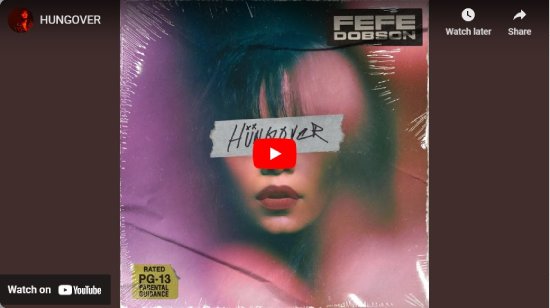“In my world,” Fefe Dobson explains about her songwriting, “there’s a map to creating something that’s hooky, and turns the ear on constantly, so that there’s no boring parts. Melody is more universal than words, in many ways.”
Dobson’s songs have always seemed very personal and very introspective, even though the emotions and experiences she expresses in them are universal. That became evident almost immediately upon the release of her self-titled debut in 2003. Fefe Dobson entered the Billboard HeatSeekers album chart at No. 1 and spawned four consecutive Top 10 radio hits, including “Bye Bye Boyfriend” and “Take Me Away.” That led to multiple award nominations (including Best New Artist and Pop Album JUNO noms), earned two MuchMusic video awards and, ultimately, landed her a spot opening for Justin Timberlake’s 2004 European tour.
In the 20 years since, there’ve been three more albums, including the newly released Emotion Sickness. Dobson moved from Scarborough to Los Angeles, and now resides in Nashville; got married; had several more hit singles; and sustained a successful part-time acting career. She’s also had songs she co-wrote recorded and released by the likes of Miley Cyrus, Selena Gomez, and Jordin Sparks.
Dobson has garnered a reputation for making tough decisions over the years, including rejecting an early contract offer she thought was inappropriate, and scuppering the release of a completed album with which she didn’t feel comfortable. The single “FCKN in Love,” which survived that rejected album, has been streamed more than 2.4 million times on Spotify since its release in 2022.
While her lyrics – almost all of which are solely written by Dobson on Emotion Sickness – obviously resonate with a large audience, they’re not the driving force behind the music. On the phone from Ottawa, where she performs that night as part of a nine-date Fall 2023 Canadian tour, Dobson says, “For me it’s always been melody first. Lyrics come afterwards. It’s always been like that. I’ve been very fortunate that way. Even from the very beginning.”
Five of Emotion Sickness’ nine tracks were co-written with Bryn McCutcheon, Kirstyn Johnson, and the album’s producer, multi-instrumentalist Sam Arion, all of whom reside in Toronto. Dobson hadn’t really intended to start working on an album, but on creating what would become the opening track – the bombastic, high-energy “Hungover” – it almost became a necessity.
“At first I was kind of shy about it,” Dobson recalls, “because I hadn’t written a punk song like that in years, just, like, balls-to-the-wall. I thought, Oh my God, will my team even like this? I thought I was making a song that was just about what I felt at the moment, not a song that would carry a project. And I got a call from my team, and it was, like, ‘We need to make an album right now!’ The Toronto aspect, the Canadian aspect of it, just happened that way, which was kind of nice. It was like going to my roots.” With the likes of Olivia Rodrigo and a resurgent Avril Lavigne bringing the sound of pop-punk back into popular culture, it’s no wonder Dobson’s team was excited.
While her songs tend to alternate between keyboard- and guitar-driven tracks, they don’t necessarily start out that way. For example, the dynamic, rocking, anthemic, “I Can’t Love Him (And Love You Too)”, started out on acoustic guitar. “We didn’t know if it was an old, doo-wop song,” says Dobson. “We didn’t know what the song would transform into.” When adding lyrics, Dobson says she’ll vocalize sounds, then find words that fit. “Certain sounds will come out of our mouths, and I want to write words to match that,” she says. She refers to a friend and supporter, producer Jim Jonsin (Grammy-winning producer/songwriter who’s worked with Beyoncé, Usher, Lil Wayne, and Eminem). “He calls it ‘holy ghosting,’ where it comes from a higher power, or someplace,” she says. “It’s like something speaking through you, and I honour that.”
Dobson says another 10-year wait for her next album is unlikely. She admits to being shocked by the great response to her new songs. “The first night [of the tour] in Toronto, which was the album release day,” she says, “we started the show with ‘Ghost,’ which was great, everyone was familiar with it. Then we did [new song] ‘Shut Up and Kiss Me,’ and when that chorus hits, it always blows my mind. Every show, it was the same way, with people jumping up and down. The new stuff is coming off really well. It’s making me happy because I’m, like, ‘OK this is connecting.’”
Dobson chose a very comfortable, if unusual, environment to write most of what became Emotion Sickness: her favourite corner room at the Fairmont Royal York Hotel – a place she considers her second home, when in Toronto. “We just set up mics and we started writing and recording vocals,” says Dobson. “I literally sat, listening on the bed, in my hotel room. We were writing the songs, mapping them out.” Some of the vocals recorded there, including those on “Shut Up and Kiss Me,” made it onto the album. With microphones, guitars, and keyboards all plugged directly into laptops, no one in the neighbouring rooms complained.
